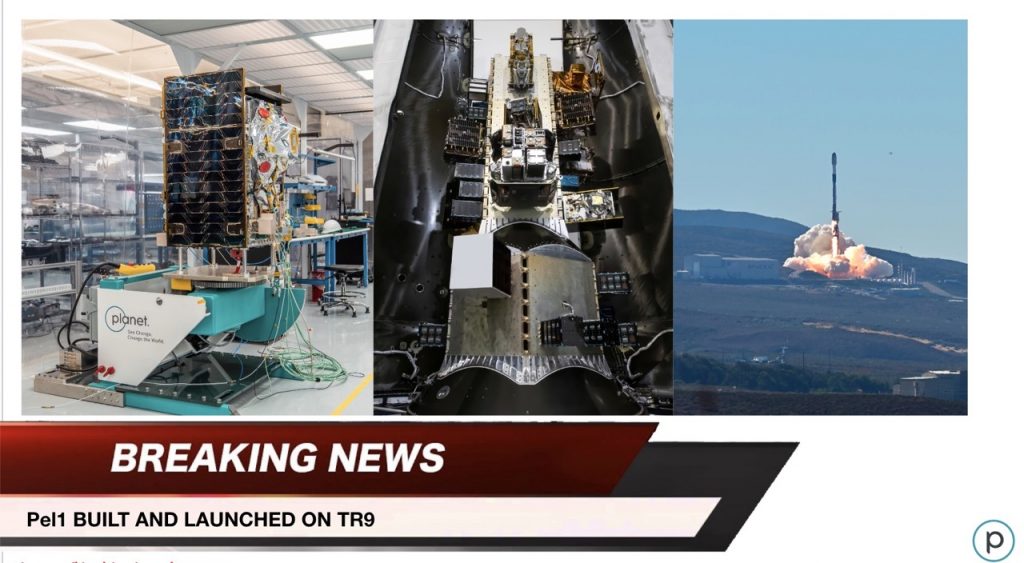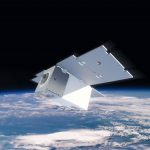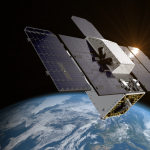Planet’s modular, extensible smallsat platform enables new missions including Pelican and Tanager
In November 2023, Planet launched Pelican-1, the first technology demonstration small satellite of our next-generation, high-resolution Pelican constellation that is expected to be deployed over the next few years. The primary mission of Pelican-1 is to validate the hardware and software aspects of Planet’s small satellite bus platform, which we call the Smallsat Platform. This platform is common between our Pelican and Tanager constellations, and is designed, manufactured, integrated, and tested entirely in-house at Planet HQ.
The Smallsat Platform is only the tip of the pyramid. It consists not only of the satellite bus, but also Planet’s global network of ground stations, mission control, and autonomous mission operations. This vertically integrated infrastructure represents Planet’s decade-long investment in multi-mission operations and lean, just-in-time manufacturing and testing.

Pelican is a very high-resolution and high-agility optical imaging satellite, designed to supplement and improve upon Planet’s existing SkySat constellation as it comes online in the coming years. The Tanager constellation will carry a hyperspectral instrument equipped with around 400 spectral bands, delivering hyperspectral data at 30 meter resolution that will help customers reveal social, environmental, and climate risks in unprecedented detail.

The Smallsat Platform combines best-in-class performance aspects of both our flagship Dove satellites and advanced SkySat constellation. It is modular, flexible, and extensible, and is compatible with multiple launch providers. Further, the Smallsat Platform capabilities include: a 600W power system, a high agility platform that can hold arc-second pointing accuracy and stability, multiple space qualified processors including state-of-the-art FPGAs, GPUs and multiple terabytes (TBs) of onboard storage capacity, low and high speed comms busses (CAN, Ethernet, SpaceFiber, PCIe), TT&C radio, high speed uplink and downlink radios, and advanced features such as real time intersatellite-link connectivity, forward looking wide-field-of-view secondary cameras, and an onboard edge compute platform. This platform is interoperable with the entire Planet infrastructure from order management to ground operations to our imagery pipeline and analytics.

With a planned peak downlink rate of 10Gbps, each satellite is expected to be able to downlink 1-2TB per day via a flexible global ground network. This data will be backhauled from our globally distributed ground stations to our cloud platform for image processing, insight extraction, and dissemination to customers. Three sites are already operational and actively supporting Pelican-1 and Eight Ka-band ground sites are planned with phased deployments through 2025 to support Planet’s upcoming missions. Ground stations location will be optimized to meet coverage and latency goals for our customers in a cost-efficient manner.
Check out the Key Specifications of the Smallsat Platform here.
Vertical Integration
Planet has over a decade of vertically integrating and delivering best-in-class manufacturing and mission automation. Planet’s manufacturing lab spans over 35,000 square feet, which includes state-of-the-art environmental testing labs, cleanroom facilities ranging from ISO 7 to ISO 8, and a research and development (R&D) facility. With fully integrated space qualification labs, our current factory can manufacture up to 24 small satellites per year, like Pelican, in addition to 80 cubesats, like our SuperDoves. Lean, just-in-time manufacturing and test automation means that all of our processes, designs, and supply chain are built for scalable and agile engineering. We are currently testing the next generation of fully automated satellite operations via our world class mission control and ground station network.
Check out the Key Specifications of our state-of-the-art manufacturing lab here.
The interoperability and adaptability of the Smallsat Platform brings faster evolution to each mission, improving resilience and reliability in our mission architecture and enabling us to support new instruments that deliver new capabilities to the market. To learn more, visit our website.




